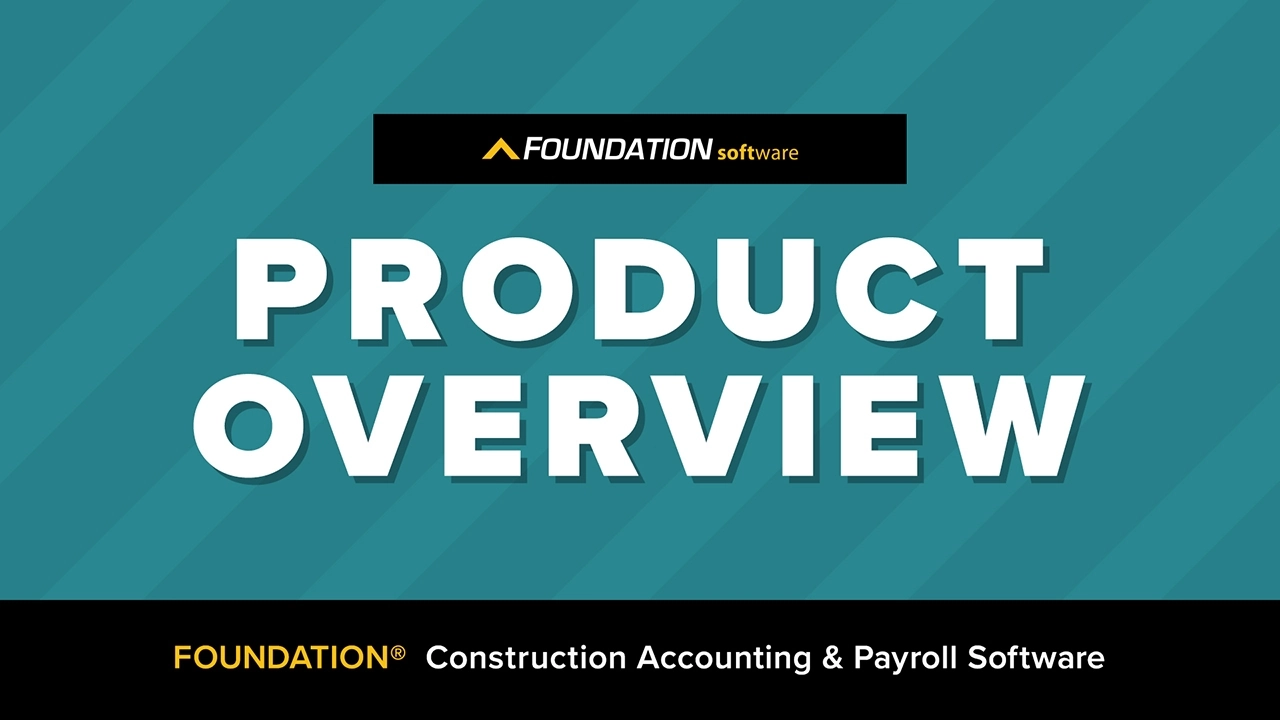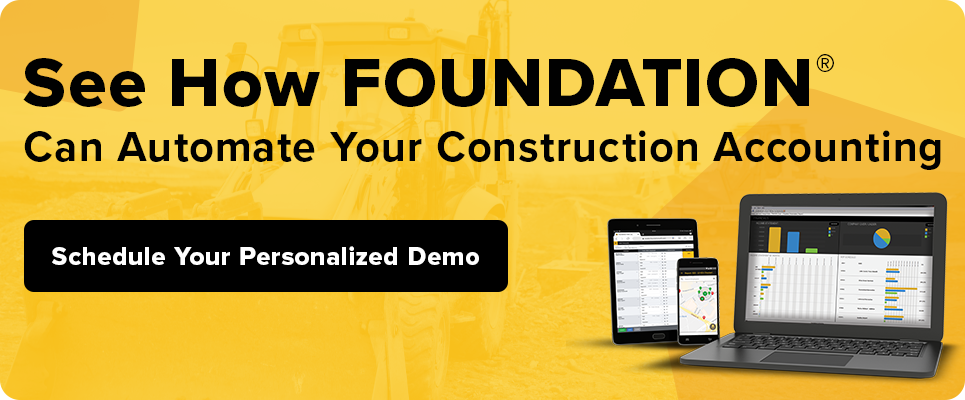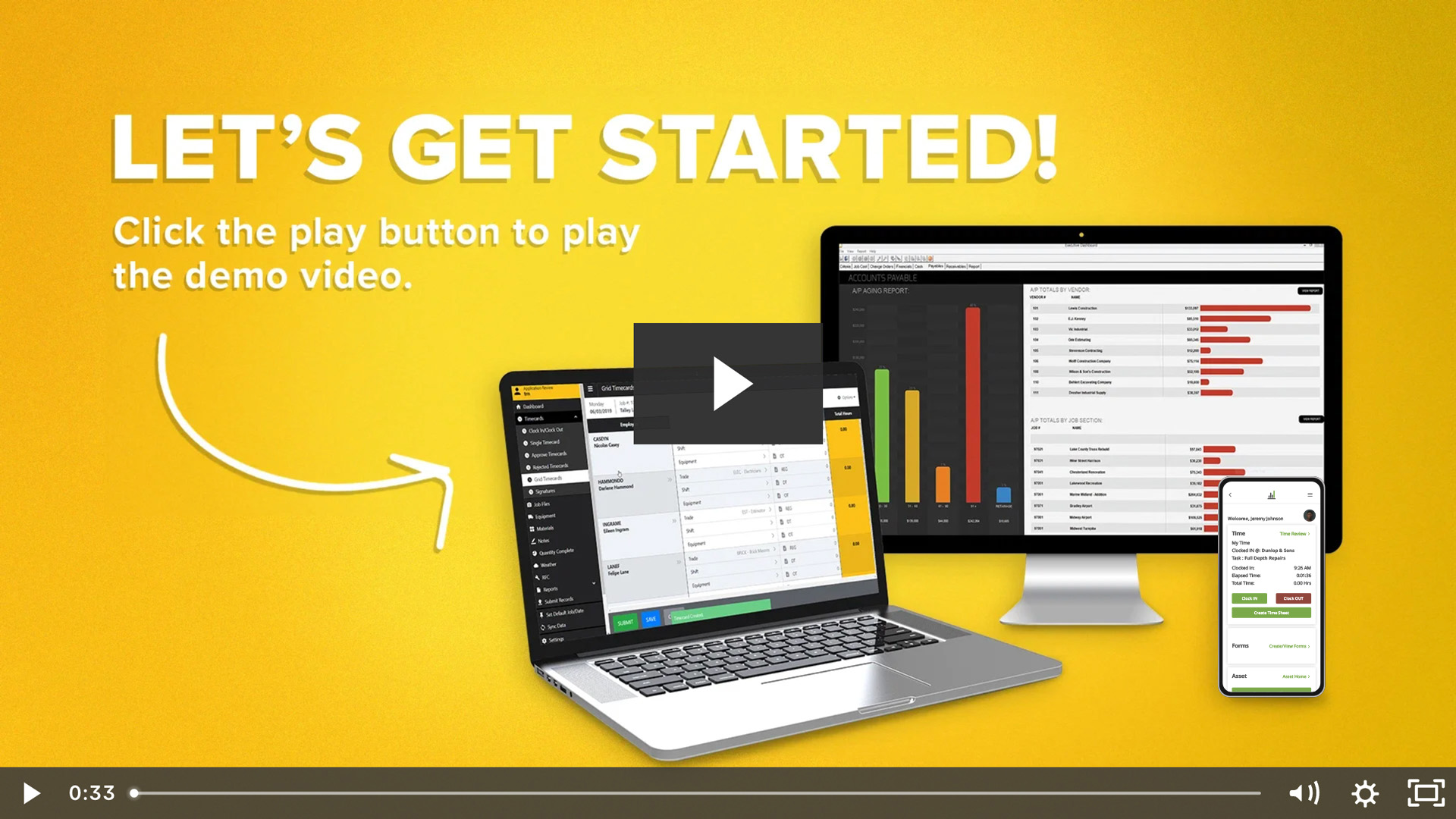
Managing multiple profit centers simultaneously makes construction accounting uniquely complex compared to businesses with single revenue streams.
Between juggling multiple projects, tracking equipment costs, managing subcontractor payments and complying with regulations, construction professionals often find themselves drowning in financial complexities.
Many contractors struggle with things like:
- Cash flow issues
- Cost overruns
- Inaccurate project profitability reports
- Long-term contracts
- Job costing requirements
- Percentage-of-completion methods
These construction industry struggles make traditional accounting approaches fall short.
Mastering construction accounting principles, from job costing fundamentals to revenue recognition methods, provides contractors the financial foundation to build profitable, sustainable businesses.
Key Takeaways for Construction Accounting Success
- Job costing is essential – Track labor, materials, equipment, and overhead costs by specific project to identify profitability and control expenses.
- Cash flow management differs from traditional businesses – Construction requires managing irregular payment patterns and significant upfront investments before client payments arrive.
- Revenue recognition uses specialized methods – Most contractors benefit from the percentage-of-completion method rather than waiting until project completion to recognize income.
- Technology integration streamlines operations – Modern construction accounting software automates job costing, reporting, and compliance while providing real-time project insights.
- Compliance requirements are complex – Navigate varying sales tax rules, labor laws, retention requirements, and specialized tax opportunities unique to construction.
What Is Construction Accounting and Why It’s Different From Traditional Accounting
Construction accounting isn’t just regular bookkeeping. It’s a specialized field that addresses the unique challenges of the commercial construction industry.
Unlike retail or service businesses that deal with straightforward transactions, construction companies manage long-term projects that can span months or years. Each project has multiple revenue streams and complex cost structures.
The fundamental difference is that construction companies operate multiple profit centers simultaneously, with each project requiring its own detailed cost tracking and profitability analysis.
The unique nature of construction accounting creates three primary characteristics that differentiate it from traditional business accounting:
- Specialized job costing
- Complex revenue recognition
- Irregular cash flow patterns
Let’s explore each one below
Specialized Job Costing Requirements
Construction accounting requires specialized job costing to track labor, materials, equipment, and overhead at the project level.
While a restaurant tracks food costs and labor for daily operations, construction companies must track costs for specific projects. They need to break down expenses by labor, materials, equipment and overhead for each jobsite.
This level of detail helps contractors understand which projects are profitable and which ones are bleeding money.
Complex Revenue Recognition
Contractors recognize revenue using methods like percentage-of-completion, which aligns income with project progress.
Instead of recognizing revenue when a sale is complete, construction companies often use the percentage-of-completion method. Using this method means revenue is recognized gradually as work progresses, matching it with the costs incurred.
For example, in a six-month bridge project, revenue might be recognized monthly based on completion milestones rather than waiting until the bridge is finished.
Irregular Cash Flow Patterns
Construction companies often face irregular cash flow because they spend heavily on labor and materials before receiving client payments.
Progress billing helps, but there are still gaps between when money goes out and when it comes in. Many construction companies look profitable on paper while struggling to meet payroll because their cash is tied up in ongoing projects.
Core Elements of Construction Accounting
Understanding these three foundational challenges leads us to the core elements that make construction accounting systems effective.
Construction accounting encompasses several interconnected components that work together to provide comprehensive financial management for construction companies. These fundamental elements include:
- Job costing
- Cash flow management
- Revenue recognition
- Billing and invoicing
All of these elements are essential aspects of construction accounting that differentiate it from traditional business accounting.
Mastering Job Costing: The Heart of Construction Accounting
Job costing forms the foundation of successful construction accounting by providing detailed insight into project profitability and cost control.
Job costing is the process of tracking all costs associated with specific construction projects, broken down by categories like:
- Labor
- Materials
- Equipment
- Overhead
Unlike businesses that track costs company-wide, construction companies must understand profitability at the individual project level.
Effective job costing enables contractors to:
- Identify which types of projects generate the highest profits
- Spot cost overruns before they become major problems
- Improve bidding accuracy for future projects
- Make data-driven decisions about resource allocation
- Demonstrate project performance to clients and stakeholders
Job costing requires establishing a coding system that categorizes all project expenses. Common cost codes include:
- Direct labor by trade (carpentry, electrical, plumbing)
- Materials by category (wood planks, steel beams, fixtures)
- Equipment costs (rentals, fuel, maintenance)
- Subcontractor expenses
- Project overhead (supervision, permits, temporary facilities)
Each expense must be assigned to the appropriate project and cost code, creating a detailed picture of where money is being spent and how it compares to the original budget.
Construction Cash Flow Management
Cash flow management in construction balances project expenses with client payments to keep operations running smoothly.
Successful cash flow management includes:
- Negotiating favorable payment terms with clients
- Implementing efficient billing processes to minimize payment delays
- Managing supplier payment terms to optimize cash outflow timing
- Maintaining accurate cash flow forecasts that account for project timing
- Building relationships with reliable financing sources for working capital needs
Revenue Recognition in Construction
Revenue recognition determines when construction companies record income, directly impacting financial statements and tax obligations.
The percentage-of-completion method recognizes revenue based on project progress rather than payment timing. This method:
- Matches revenue with incurred costs for more accurate profitability reporting
- Provides stakeholders with ongoing insight into project performance
- Requires accurate measurement of work completed and costs to complete
- Demands sophisticated accounting systems to track multiple project stages
The completed contract method recognizes all revenue when the project is finished. While simpler to implement, this method:
- Can create uneven revenue patterns that don’t reflect actual business activity
- May not provide timely insight into project profitability
- Is generally only appropriate for smaller contractors or short-term projects
Choosing which method fits best for your business depends on factors such as project duration, contract size and company resources.
Most larger contractors benefit from the percentage-of-completion method for better financial visibility. Smaller companies with shorter projects may find the completed contract method more practical.
Construction Billing and Invoicing
Billing and invoicing processes link project milestones to payment schedules, ensuring contractors get paid on time.
Effective billing and invoicing processes are critical components of construction accounting that directly impact cash flow by minimizing the time between work completion and payment receipt.
Effective progress billing includes:
- Clear billing schedules established in contracts
- Detailed documentation of work completed
- Prompt submission of invoices upon reaching billing milestones
- Follow-up processes to ensure timely payment
- Integration between project management and billing systems
Retention management requires:
- Tracking retention amounts by project and client
- Understanding release requirements and timelines
- Following up on retention releases promptly
- Factoring retention timing into cash flow forecasts
Common billing types in construction include:
- Progress billing: Monthly invoices based on the percentage of work completed
- Milestone billing: Payments tied to specific project achievements
- Unit price billing: Charges based on quantities of work performed
- Time and materials billing: Hourly rates plus material costs
- Lump sum billing: Fixed payment schedule regardless of actual costs
Operational Components That Drive Construction Financial Success
The core accounting elements provide the foundation. But successful construction companies must also manage several operational components that directly impact financial performance and require specialized accounting treatment.
These operational elements work hand-in-hand with the accounting fundamentals to create a comprehensive financial management system.
Project Accounting
Project accounting tracks all costs and revenues associated with specific jobs, providing the detailed information contractors need for effective decision-making.
This includes direct costs like materials and labor. It also includes indirect costs such as equipment depreciation and administrative overhead.
Contract Management
Contract management defines how contractors get paid by setting terms for cash flow, revenue recognition, and project risk.
Contractors must understand different contract types, such as:
- Lump sum contracts
- Cost-plus contracts
- Time and materials contracts
Contractors also need to understand how each affects cash flow and risk.
For example, a lump sum contract provides predictable revenue but shifts cost risk to the contractor. Meanwhile, cost-plus contracts offer more flexibility but require meticulous documentation.
Subcontractor Management
Subcontractor management requires tracking work, payments, and retention to maintain accurate records and protect cash flow. It adds another layer of complexity for contractors.
General contractors must track subcontractor work, manage payments and ensure proper documentation for both legal and financial purposes.
This includes managing retention amounts, which affects cash flow planning.
Equipment Accounting
Equipment accounting tracks depreciation, maintenance, and utilization so contractors can measure actual project costs. It requires special attention in construction. Companies must decide whether to buy, lease or rent equipment.
Then, they need to properly account for depreciation, maintenance costs and utilization rates.
A piece of heavy machinery sitting idle represents a significant drain on profitability. This makes equipment tracking essential for accurate job costing.
Change Order Management
Change order management updates budgets and cost reports whenever clients request modifications to original project plans.
When clients request modifications to original plans, contractors must quickly assess cost impacts, document changes and adjust project budgets accordingly.
Poor change order management is one of the fastest ways to turn profitable projects into financial disasters.
Building Accurate Project Budgets and Cost Estimates

Construction budgeting estimates labor, materials, and overhead to create a roadmap for project profitability. It provides the baseline for meaningful job cost analysis.
Construction estimating starts with detailed quantity takeoffs from project plans. They measure every component that will require materials or labor.
This painstaking process forms the foundation for reliable cost projections.
What Makes a Construction Budget Effective
A well-constructed budget includes:
- Detailed line items for all direct costs
- Properly allocated overhead
- Realistic contingencies
- Clear assumptions about productivity rates and market conditions
Contractors should regularly compare actual costs to budgeted amounts to identify patterns and improve future estimating accuracy.
Labor Cost Estimation
Labor cost estimation involves more than just hourly wages. Contractors must factor in things like:
- Payroll taxes
- Benefits
- Workers’ compensation insurance
- Productivity rates
These can vary by project type and conditions.
A crew that installs drywall quickly in ideal conditions might work much slower in cramped spaces or extreme weather. Such conditions significantly affect labor costs.
Material Cost Estimation
Material cost estimation requires understanding market conditions, delivery schedules and waste factors.
Construction professionals often build in 5-15% waste factors depending on material type and project complexity.
They also must consider material escalation clauses for long-term projects. That’s because commodity prices can fluctuate significantly during construction periods.
Equipment Costs
Equipment costs include ownership, operating, and rental expenses that contractors must allocate to specific jobs. It also includes operating costs such as fuel, maintenance and operator wages.
Contractors must decide whether to use owned equipment, rent or subcontract work requiring specialized machinery.
Each option has different cost implications and risk profiles.
Indirect Costs And Overhead Allocation
Overhead allocation assigns indirect costs like supervision, permits, and utilities to projects so contractors can calculate profitability accurately. These include:
- Site supervision
- Permits
- Temporary utilities
- Site security
- Administrative expenses
Construction companies typically allocate overhead using one of two main approaches:
- Applying an equal percentage across all projects
- Calculating different percentages for each project based on specific factors.
Most contractors allocate overhead as a percentage of direct costs, but this method requires regular analysis to ensure accuracy.
Companies must track overhead expenses carefully and distribute them fairly across projects.
For example, a company might allocate administrative overhead based on direct labor hours across all projects, while allocating equipment overhead based on equipment usage hours per project.
Contingency Planning
Contingency planning protects against unforeseen circumstances. Experienced contractors build contingencies of 5-20% into their estimates depending on project complexity and risk factors.
Weather delays, design changes and site conditions can all impact costs. That’s why contingency planning is essential for maintaining profitability.
Types of Construction Financial Reports Every Contractor Needs
Construction companies require specialized accounting reports that go beyond standard financial statements to provide actionable insights for decision-making.
Job Cost Reports
Job cost reports top the list. They break down costs by project and compare actual expenses to budgeted amounts.
These reports help contractors identify cost overruns early and make adjustments before problems spiral out of control.
Work-In-Progress (WIP) Reports
Work-in-progress reports provide crucial insights into project status and profitability.
These reports show:
- How much work has been completed
- How much revenue has been recognized
- What costs remain to finish each project
WIP reports help management understand which projects are ahead or behind schedule and budget. This enables proactive management decisions.
Cash Flow Forecasts
Cash flow forecasts are vital for construction companies due to the irregular nature of project payments.
These reports project when money will come in from completed work and when major expenses are due. This helps contractors plan for equipment purchases, payroll and other financial obligations.
A good cash flow forecast can prevent the common construction scenario of being profitable but cash-poor.
Retention Tracking Reports
Retention tracking reports monitor the money being held back by clients until project completion.
Since retention can represent 5-10% of total contract value, tracking these amounts is crucial for accurate financial planning.
Contractors need to know when retention will be released and factor these amounts into cash flow projections.
Equipment Utilization Reports
Equipment utilization reports help construction companies understand whether their equipment investments are paying off.
These reports track:
- How often each piece of equipment is used
- Its revenue generation
- Associated costs
Underutilized equipment represents a significant drain on profitability and may indicate the need to sell, rent out or better schedule equipment use.
Profitability Analysis Reports
Profitability analysis reports compare actual project profits to estimates. This type of report helps contractors improve their bidding accuracy over time.
These reports identify which types of projects, clients or project managers consistently deliver the best returns, informing future business development strategies.
How Technology Transforms Construction Accounting
Construction accounting software automates job costing, billing, and compliance, turning manual processes into real-time insights.
The financial reports and accounting processes we’ve discussed can be overwhelming to manage manually.
This is where modern construction accounting software becomes essential. It transforms these complex financial management tasks from time-consuming manual processes into streamlined, automated systems that provide real-time insights.
Automated Job Costing
Job costing modules automatically track costs by project, phase and cost code. This provides real-time visibility into project profitability.
Automation capabilities can eliminate manual spreadsheets that many smaller contractors still rely on, reducing data entry time while improving accuracy.
Integrated Project Management
Integrated project management features connect scheduling, budgeting and cost tracking in a single system.
When project schedules change, the software automatically updates cash flow projections and resource requirements. This eliminates the need to manually update multiple systems.
This integration helps construction professionals make informed decisions based on current project status rather than outdated information.
Real-Time Mobile Data Entry
Real-time mobile data entry syncs labor hours, materials, and progress updates from the field directly into the accounting system.
This real-time data entry improves accuracy and eliminates the delay between field activities and financial reporting. Photos, notes and quality control information can be captured and linked to specific cost codes and work items instantly.
Detailed Financial Reporting
Automated reporting eliminates the manual effort required to create WIP reports, job cost summaries and other essential financial documents. It reduces report preparation time from hours to minutes.
Construction companies can schedule reports to run automatically and distribute them to stakeholders. This ensures everyone has access to current project information without administrative delays.
Seamless System Integrations
Integration capabilities allow construction software to connect with other business systems. These integrations eliminate duplicate data entry and ensure consistency across all business functions.
Systems integrate with:
- Payroll
- Equipment management
- Document control
For example, when a timesheet is approved in the field, it automatically flows to payroll and job costing without manual intervention or data re-entry delays.
Compliance Management
Compliance features help contractors meet regulatory requirements automatically, generating required reports and maintaining audit trails without manual tracking.
Automated compliance management covers:
- Certified payroll
- Retention tracking
- Lien management
This automation is important for government contracts that have strict documentation requirements and tight deadlines.
Compliance, Regulations and Tax Considerations
Construction accounting must address compliance with sales tax, labor laws, workers’ compensation, and contract reporting rules.
Sales Tax
Sales tax compliance presents unique challenges in construction due to varying rules about materials, labor and services.
Contractors must understand whether they’re selling materials to clients or using them in providing services. The difference affects sales tax obligations.
Rules vary significantly between states and municipalities, requiring careful attention to avoid costly penalties.
Labor Laws
Retention and lien laws protect subcontractors and suppliers but create obligations for general contractors.
Contractors must understand:
- Mechanics’ lien deadlines
- Notice requirements
- Retention release procedures
Failure to comply with these laws can result in expensive legal disputes and payment delays.
Workers’ Compensation
Workers’ compensation and unemployment insurance require accurate job classification and wage reporting.
Construction workers often perform multiple job functions with different risk ratings, affecting insurance costs. Contractors need systems to track worker activities accurately and calculate appropriate insurance premiums.
Tax Preparation
Tax planning opportunities exist for construction companies willing to invest in proper planning.
Section 199A deductions for pass-through entities can provide significant tax savings.
Equipment depreciation strategies, including bonus depreciation and Section 179 expensing, can help contractors manage tax liabilities while investing in business growth.
Contract Accounting
Contract accounting rules under ASC 606 affect how construction companies recognize revenue and report financial results.
While these rules primarily impact larger companies, understanding the principles helps all contractors improve their financial reporting accuracy and consistency.
Master Construction Accounting With FOUNDATION®
Effective construction accounting serves as the foundation for building a profitable and sustainable construction business.
Construction professionals who invest in proper financial systems, training and processes gain significant competitive advantages, such as:
- Better project control
- Improved cash flow management
- More accurate bidding
The specialized nature of construction accounting requires dedicated expertise and appropriate technology solutions.
FOUNDATION construction accounting software integrates job costing, project management, payroll and financial reporting in a single system designed specifically for contractors.
FOUNDATION helps contractors improve project profitability, streamline operations and make better business decisions based on accurate, timely financial information.
Ready to take control of your construction accounting and business finances? Contact our team of experts here to learn more.
Share Article
Keep on current news in the construction industry. Subscribe to free eNews!
Our Top 3 YouTube Videos
Learn about our software more in depth with product overviews, demos, and much more!

Our ACA reporting & e-filing services include official 1094-C and 1095-C IRS reporting, optional e-filing (no applying for a TCC code required), mailing to your employees and experienced support to help you.

There are plenty of reasons to make FOUNDATION your choice for job cost accounting and construction management software — just ask our clients!

From job cost accounting software, to construction-specific payroll. Get an overview on your next all-in-one back-office solution.





